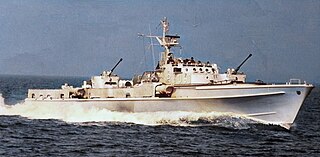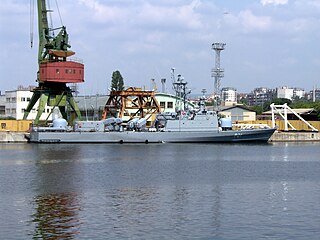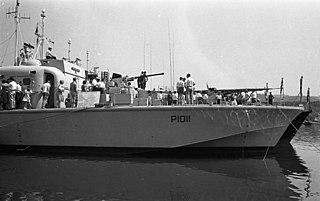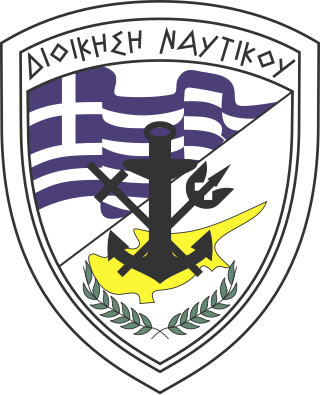
Whiskey-class submarines are a class of diesel-electric attack submarines that the Soviet Union built in the early Cold War period.

The Type 201 was Germany's first U-boat class built after World War II.

The Type 140 Jaguar-class fast attack craft is an evolution of the German torpedo boats (E-boats) of World War II. The design was developed by Lürssen and designated Schnellboot 55. The 20 boats that were built for the German Navy were in service from 1957 to 1975. Then the Jaguar-class boats were replaced in service with the Bundesmarine by the Tiger class.

The Nasty type patrol boats were a series of fast patrol boats designed and built in Norway during the 1950s and 1960s for the Norwegian, and other, navies.

German submarine UA was one of fourteen foreign U-boats in the German Kriegsmarine during the Second World War.

The La Combattante III type missile boats are two classes of fast attack craft built for the Hellenic Navy. The first group of four were ordered by Greece in September 1974 from France. The vessels had no class name but are referred to by type. They are similar to the La Combattante IIa-class fast attack craft already in service, but are larger and armed with torpedoes. A second group of six were ordered in 1978, to be built under license in Greece and use the Norwegian Penguin Mk 2 Mod 3 missiles. Since 2019, all the ships of the class use Harpoon anti-ship missiles.

A motor launch (ML) is a small military vessel in Royal Navy service. It was designed for harbour defence and submarine chasing. Similar vessels were used by the Royal Air Force for armed high-speed air-sea rescue. Some vessels for water police service are also known as motor launches. Motor launches were slower than motor torpedo boats and motor gun boats

The Brave-class fast patrol boats were a class of two gas turbine motor torpedo boats (MTBs) that were the last of their type for the Royal Navy (RN) Coastal Forces division. They formed the basis for a series of simpler boats which were widely built for export.

The R boats were a group of small naval vessels built as minesweepers for the Kriegsmarine before and during the Second World War. They were used for several purposes during the war, and were also used post-war by the German Mine Sweeping Administration for clearing naval mines.

The Cyprus Naval Command is the armed sea wing of the Cyprus National Guard. The Cypriot Navy has the primary mission of defending the maritime borders of the Republic of Cyprus, but is currently unable to access the waters around Northern Cyprus, which have been controlled by the Turkish Navy since the 1974 Turkish invasion of Cyprus. This force does not possess any capital ships or other major warships, but is equipped with patrol boats, landing craft, surface-to-surface missile systems and integrated radar systems, as well as SEALs-type naval underwater demolitions units.

HNoMS Nasty was a fast attack craft of the Royal Norwegian Navy, built as a private venture by Westermoen Båtbyggeri of Mandal, Norway. Designed by Jan Herman Linge she was an experimental craft, of wooden hull construction, launched in 1958. Nasty served with the Royal Norwegian Navy and was the prototype for the navies Tjeld class patrol boats. Boats to Nasty's design were also built for the US and German navies. Nasty was stricken in 1967.

The Nasty class of fast patrol boats were a set of 20 vessels built for the United States Navy to a Norwegian design and purchased in the 1960s for covert operations during the Vietnam War. Following the conflict they remained in service until the early 1980s.
For other ship classes of the same name see Nasty-type patrol boat

The Greek Tjeld type patrol boats were a set of six fast patrol boats built to a Norwegian design and operated by the Hellenic Navy during the 1960s and early 1970s.

The Tjeld class was a class of twenty fast patrol boats designed and built for the Royal Norwegian Navy in the late 1950s. They were used as torpedo boats in Norway where this type of vessel were called MTBs or motor torpedo boats (motortorpedobåt). They remained in service until the late 1970s, when they were placed in reserve; all were stricken by 1995.

PTF-3 is United States Nasty-class patrol boat, now a museum ship at the DeLand Naval Air Station Museum, DeLand, Florida. PTF-3 is called Fast and Nasty. PTF-3 was built in 1962 by the Westermoen Båtbyggeri in Mandal, Norway. PTF-3 is small river gunboat built with an aluminium hull. The United States Navy used PTF-3 in the Vietnam War from 1962 to 1966 in the Brown-water navy. PTF-3 has a top speed of speed of 38 knots. She is a Nasty-class patrol boat at 80 ft 4 in (24.49 m) long. PTF Boats replace the wooden World War II PT boats. The PTF-3 was armed with two Oerlikon 20 mm cannon, .50 caliber Browning machine gun and 81mm mortar "Piggyback". PTF 3 and PTF-4 were delivered to the U.S. Navy in 1963 at Little Creek, Virginia. The two boats were tested at Little Creek. Training on the boat started on May 3, 1963 at Naval Base Coronado. PTF 3 and PTF-4 departed Coronado on September 17th loaded on USS Point Defiance) a Landing Ship Dock ship. Point Defiance took the boats to Pearl Harbor, Hawaii and then to U.S. Naval Base Subic Bay in the Philippines. At Subic Bay the boats were upgraded and then shipped to Ðà Nẵng Vietnam on the USS Carter Hall. But PTF-3 suffered major damage to its hull during loading and was repaired at Subic Bay arriving at Ðà Nẵn February, 1964. PTF 3 became a Spook Boat, operated by MAC V SOG, Maritime Special Ops. PTF 3 was one of 6 PTF boats that did raids in North Vietnam, attacking shore installations and landing special operations teams. PTF-3 took part in the 1964 Tonkin Gulf Incident and had mission in Vietnam 9 years. On July 31, 1964 PTF-3 and other boats took part in landing two teams of South Vietnamese commandos on the North Vietnamese held small island of Hon Me, the start of the Tonkin Gulf incident, that lead to the Tonkin Gulf Resolution. In 1966 she was transferred to the South Vietnamese Navy. In 1970 she was returned to US Navy and had missions in Cuba and Nicaragua working with the CIA based in Diver Training Facility at Key West Florida. In 1977 she was remove from the US Navy and sold in 1978. From 1978 to 2001 she was docked in South Florida unused with no engines. In December 2001 she started used as Sea Scout ship in Orange City, Florida, purchased in Fort Lauderdale, Florida by Bill Norton of General Propulsion who donated the boat to Boy Scout Troop 544 in December 2001. Troop 544 started a non- profit, 501c3 corporation: PTF 3 Restoration Project, Inc, to handle the restoration. In May 2003 PTF-3 was moves to DeLand Naval Air Station Museum for restoration, arriving on 29 July 2003 with honor guard of Veterans.












